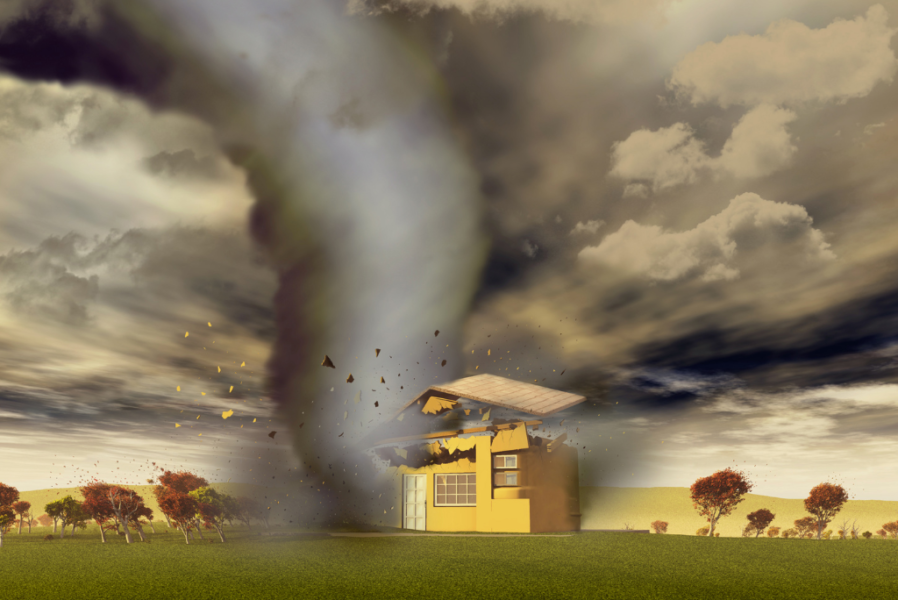Tornadoes, a harsh reality for Oklahoma City residents, can cause immense devastation in a short period. While the ideal scenario is always preparedness, the unfortunate reality is that tornadoes can strike unexpectedly. If your property is impacted by a tornado, it’s crucial to prioritize safety and take well-informed steps toward recovery. This comprehensive guide will equip you, as a property owner or real estate investor, with the knowledge and resources needed to navigate the aftermath of a tornado in Oklahoma City
Prioritizing Safety
The immediate aftermath of a tornado prioritizes the safety of yourself, your tenants, and the surrounding community. Here are crucial steps to take:
- Wait for the All-Clear: Resist the urge to rush to the scene. Emergency responders prioritize clearing debris and ensuring structural integrity before allowing public access.
- Contact Your Tenants: Check on their well-being and confirm their safety. If they are unable to be reached, consider contacting local emergency services for a welfare check.
- Monitor Local News: Stay updated on official announcements regarding road closures, evacuation orders, and designated shelters.
- Volunteer Strategically: While the urge to lend a helping hand is commendable, avoid “self-deployment.” Uncoordinated volunteers can hinder relief efforts. Look for official volunteer opportunities through reputable organizations like the Oklahoma Voluntary Organizations Active in Disaster (OKVOAD).
Securing Your Property
1. Document the Damage: Take photos and videos of the damage to your property from a safe distance. These visuals will be crucial when filing insurance claims. Capture both exterior and interior damage, focusing on structural damage, roof damage, and any damaged belongings.
2. Secure Your Property: If possible, take steps to further secure your property. Board up broken windows to prevent further damage from rain or wind and prevent potential looting. If your roof is damaged, cover it with a tarp to minimize water intrusion.
3. Contact Utility Companies: Report any downed power lines, gas leaks, or water leaks to the appropriate utility companies. Do not attempt to handle these situations yourself as they can be extremely dangerous.
Assessing the Damage
1. Contact Your Insurance Company: As soon as possible, contact your insurance company to file a claim. Be prepared to provide detailed information about the damage, including the photos and videos you documented earlier.
2. Property Damage Assessment: Work with your insurance company to schedule a professional property damage assessment. This assessment will determine the extent of the damage and the estimated cost of repairs.
3. Prioritize Repairs: Once the extent of the damage is recognized, prioritize repairs that are essential for safety and weatherproofing. This may include repairing the roof to prevent further water damage or securing damaged windows.
4. Finding Temporary Housing: If your property is uninhabitable due to the tornado damage, explore options for temporary housing. Your insurance company may offer coverage for additional living expenses while repairs are being made.
Communicating with Your Tenants
Open and transparent communication with your tenants is crucial during this challenging time. Here’s how to approach this sensitive situation:
- Tenant Safety: Express your concern for their well-being and inquire about any injuries or immediate needs.
- Temporary Housing: If the property is deemed uninhabitable, discuss options for temporary housing. This might involve utilizing renter’s insurance or exploring assistance programs.
- Lease Agreement: Review the terms of your lease agreement regarding repairs and habitability standards.
- Clear Communication: Maintain regular communication with your tenants, keeping them informed about the damage assessment, insurance claim process, and estimated timeline for repairs.
Resources and Support
1. Federal Emergency Management Agency (FEMA): Ready.gov offers comprehensive resources for disaster recovery, including financial assistance and guidance on how to find temporary housing.
2. Oklahoma Department of Emergency Management (ODEM): okc.gov provides state-specific information and resources for tornado recovery, including volunteer opportunities and mental health support services.
3. Oklahoma Voluntary Organizations Active in Disaster (VOAD): okvoad.org connects volunteers with organizations working on disaster relief efforts.
4. National Weather Service (NOAA): weather.gov provides real-time weather alerts, safety tips, and educational resources to help you stay informed about potential threats. This also allows you to receive real-time weather warnings and emergency broadcasts directly on a dedicated radio.
5. Oklahoma Department of Emergency Management – Tornadoes and Severe Storms FAQs: This comprehensive resource from ODEM provides answers to frequently asked questions about tornadoes and severe storms in Oklahoma, including preparedness tips, insurance considerations, and recovery information.
Tips to Recover Aftermath
The road to recovery after a tornado can be long and arduous. Be patient with yourself and the process. Seek support from friends, family, and community resources. Remember, Oklahoma has a strong history of community resilience. By working together, property owners, real estate investors, and the entire community can rebuild and recover from even the most devastating tornadoes.
Don’t wait for a disaster to strike! Prepare yourself and your property for the possibility of a tornado. Review your insurance policy, develop a communication plan for tenants, and consider mitigation strategies to minimize potential damage. By being proactive, you can significantly reduce the stress and disruption caused by a tornado and ensure a smoother recovery process.
Check out our other post to get some insights on How to Tornado Proof Your Property.
By Miles Vu

